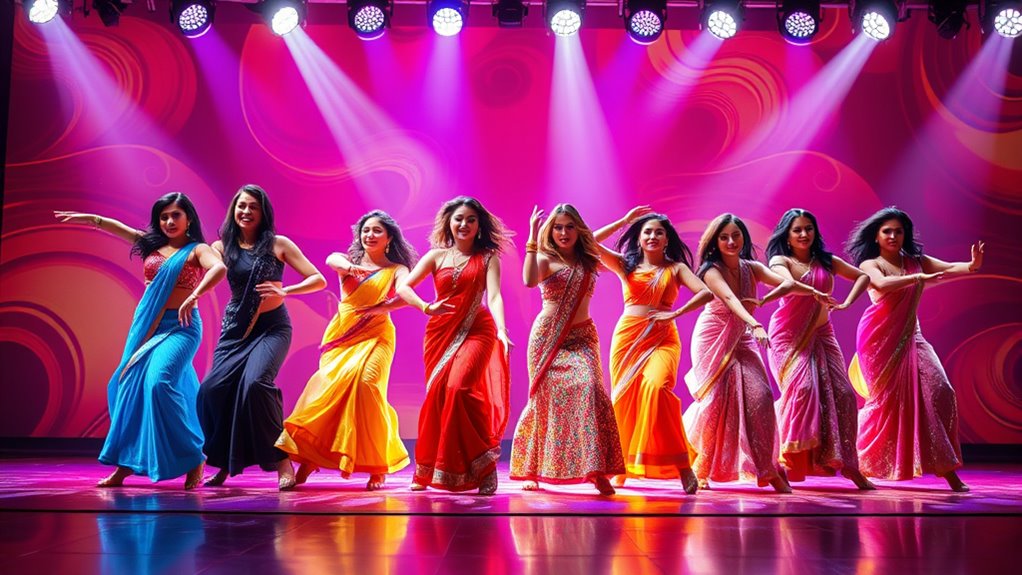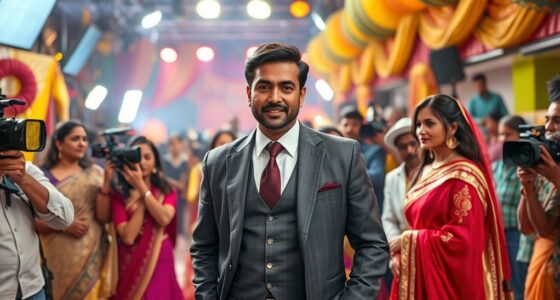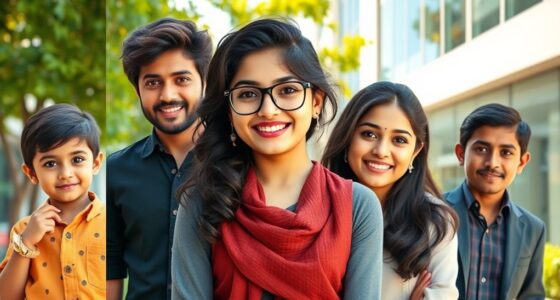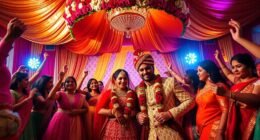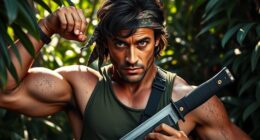If you’re looking for the top Bollywood dance numbers from the 2000s, you’ll find energetic hits like Dhoom Machale, Kajra Re, and Sharara that defined the era’s vibrant styles. Songs like Oh My Darling, Dil Laga Na, and It’s the Time to Disco also stand out with their signature choreography and fusion beats. Tere Liye, Chaiyya Chaiyya, and Mauja Hi Mauja continue to inspire dance enthusiasts. Keep exploring to uncover more of these iconic tracks.
Key Takeaways
- Includes influential hits like “Dhoom Machale” and “Kajra Re” known for their energetic choreography and cultural impact.
- Features iconic performances such as “Chaiyya Chaiyya” atop a moving train and “It’s the Time to Disco.”
- Highlights fusion of traditional Indian music with contemporary beats, showcasing Bollywood’s musical diversity.
- Emphasizes signature dance styles, vibrant visuals, and choreography that inspire dance covers and performances.
- Reflects the era’s trend of blending folk, classical, and modern dance elements in memorable numbers.
Dhoom Machale
“Dhoom Machale” is one of the most iconic Bollywood dance numbers of the 2000s, mesmerizing audiences with its energetic vibe and memorable choreography. Released on July 16, 2004, it quickly gained popularity across India and beyond. Composed by Pritam with lyrics by Sameer, it features powerful vocals from Sunidhi Chauhan and Shankar Mahadevan. The song’s lively beat and upbeat tempo perfectly match the film’s high-octane sequences. Its blend of traditional and modern instruments creates an infectious sound that keeps listeners hooked. Known for its energetic dance moves, “Dhoom Machale” became a cultural phenomenon, inspiring live performances and dance covers. This track markedly contributed to the film’s success and remains a defining number of Bollywood’s early 2000s musical landscape. Chart performance The song was Tata Young’s most successful single in India, reaching #1 across many Asian countries and dominating charts from August 2004 to late 2005.
2. Kajra Re

You can’t discuss iconic Bollywood dance numbers without mentioning “Kajra Re,” which became a massive hit in the 2000s. Its memorable dance moves and mesmerizing performances left a lasting impression on audiences worldwide. The song’s cultural impact is undeniable, as it redefined the genre and remains a favorite today. Moreover, its inspired by a folk song from Braj roots and the use of traditional Indian instruments like the sitar contributed to its distinctive sound and enduring popularity. Additionally, the popularity of “Kajra Re” showcased how traditional Indian music continues to influence contemporary Bollywood music and dance. Its success also highlights the importance of musical heritage in shaping modern Indian entertainment. Furthermore, the dance choreography incorporated traditional Indian dance forms, blending them seamlessly with contemporary styles to create a captivating performance.
Iconic Song Popularity
Why did Kajra Re become one of the most celebrated songs of the 2000s? Its infectious blend of traditional folk and modern beats captivated audiences nationwide. The song’s energetic choreography, featuring Abhishek Bachchan, Aishwarya Rai, and Amitabh Bachchan, amplified its popularity. Plus, its cultural significance made it a household name, earning praise as “the mother of all item songs” and earning awards like Best Female Playback Singer for Alisha Chinai. The song was nearly shelved during production, but its inclusion ultimately proved pivotal for the film’s success. Here are three reasons for its iconic status:
- Its catchy composition by Shankar-Ehsaan-Loy, inspired by folk from Braj, with traditional instruments like sitar.
- Its widespread media presence, including inclusion in *Caminho das Indias* and top song lists.
- Its lasting impact, becoming a symbol of 2000s Bollywood dance culture. Additionally, the song’s popularity was bolstered by its connection to the evolving Bollywood dance culture of the era.
Memorable Dance Moves
The dance moves in Kajra Re have become unforgettable symbols of Bollywood’s vibrant choreography. You’ll notice the signature hand and eye movements that emphasize flirtation and allure, creating a playful energy. Group formations shift dynamically, showcasing the dancers’ coordination and precision. Repeating iconic wrist twists and hip swivels keeps the rhythm lively and enthralling. The choreography cleverly uses space, with dancers weaving in and out of formations to keep viewers engaged. Tutorials break down these sequences, starting with basic footwork then advancing to arm and hand movements like the wrist flick paired with eye contact. Bright, traditional-fused costumes, bold makeup, and synchronized group performances further enhance the visual appeal, making Kajra Re’s dance moves instantly recognizable and inspiring for dancers worldwide. Incorporating dance choreography techniques and cultural elements enhances the overall appeal and memorability of the performance. Additionally, understanding cultural influences helps appreciate the dance’s vibrant energy and stylistic nuances, making it even more captivating. Recognizing the musical composition also adds depth to the appreciation of its choreography and the song’s overall impact. The dynamic nature of Bollywood dance often combines classical, folk, and contemporary dance forms, creating a rich tapestry of movement that energizes audiences globally. Moreover, the energetic and expressive nature of these moves reflects the Bollywood dance style, which combines classical, folk, and contemporary dance forms to create a unique visual spectacle.
Cultural Impact
Kajra Re’s cultural impact extends far beyond its popularity as a chart-topping hit, transforming it into an iconic symbol of Bollywood’s vibrant and evolving identity. It united generations, inspired countless imitations, and played a key role in shaping dance trends of the 2000s. Its fusion of folk and modern styles set a new standard for musical innovation, while the use of sitar and unique vocal accents created a distinctive sound. The lyrics evoke nostalgic urban imagery and classical motifs, connecting traditional themes to contemporary cinema. Its iconic performance by Aishwarya Rai and recognition as “the mother of all item songs” cemented its legacy in Bollywood history. The song’s popularity was amplified by its inclusion in major award shows and media coverage, and this resonance continues to influence new generations of artists and audiences. Its enduring appeal is also attributable to its musical experimentation, which pushed the boundaries of conventional Bollywood music. The song’s influence is further exemplified by its role in popularizing dance choreography that became a template for future songs. Additionally, the fusion of traditional instruments with modern beats exemplifies innovative musical blending, setting new standards for Bollywood music production. Moreover, the song’s use of state-specific asset division laws and its role in shaping cultural narratives highlight its significance in Indian pop culture. This song’s influence continues to resonate, marking a milestone in Indian pop culture and exemplifying how cultural symbols shape national identity.
3. Sharara

“Sharara” stands out as one of the most memorable Bollywood dance numbers of the early 2000s, thanks to its infectious rhythm and lively choreography. Composed by Jeet-Pritam and sung by Asha Bhosle, it combines traditional Indian music with upbeat, festive lyrics. The song’s energetic beats made it a favorite at weddings, cultural events, and dance performances, influencing many routines across India. Its colorful dance sequences in the film “Mere Yaar Ki Shaadi Hai” remain iconic. Released by Yash Raj Films, “Sharara” gained popularity on various streaming platforms and continues to be celebrated today. Its vibrant spirit and cultural significance have cemented its status as a beloved dance number from the 2000s, inspiring generations of performers and audiences alike. In addition, the song’s choreography often incorporated traditional dance moves blended with contemporary steps, showcasing the versatility of Bollywood dance styles during that era. Moreover, the song’s cultural impact reflects how Bollywood dance numbers serve as a celebration of India’s diverse artistic traditions, making them timeless favorites. Additionally, the fusion of traditional and modern dance elements highlights the evolving choreography, further enriching its dance legacy. The use of lively props and vibrant costumes in the performance also contributed to its visual appeal, making it a complete sensory experience for viewers.
4. Oh My Darling

Building on the energetic dance traditions of the early 2000s, “Oh My Darling” from Mujhse Dosti Karoge stands out as a vibrant celebration of youth and romance. You can’t help but feel the upbeat vibe from its lively choreography and catchy tune. The song’s playful mix of Hindi and English lyrics captures the spirit of the era’s pop fusion. Its bright visuals, outdoor settings, and colorful costumes make it a visual feast. The dance features synchronized group routines, energetic individual moves, and a festive mood that appeals to young audiences. Its popularity endures, with millions streaming it online. The song’s success is reflected in its high streaming numbers on platforms like Gaana. Here are three reasons why “Oh My Darling” remains iconic: 1. Catchy electro-dance fusion tune 2. Memorable choreography and visuals 3. Strong youth appeal and cultural impact
5. Dil Laga Na
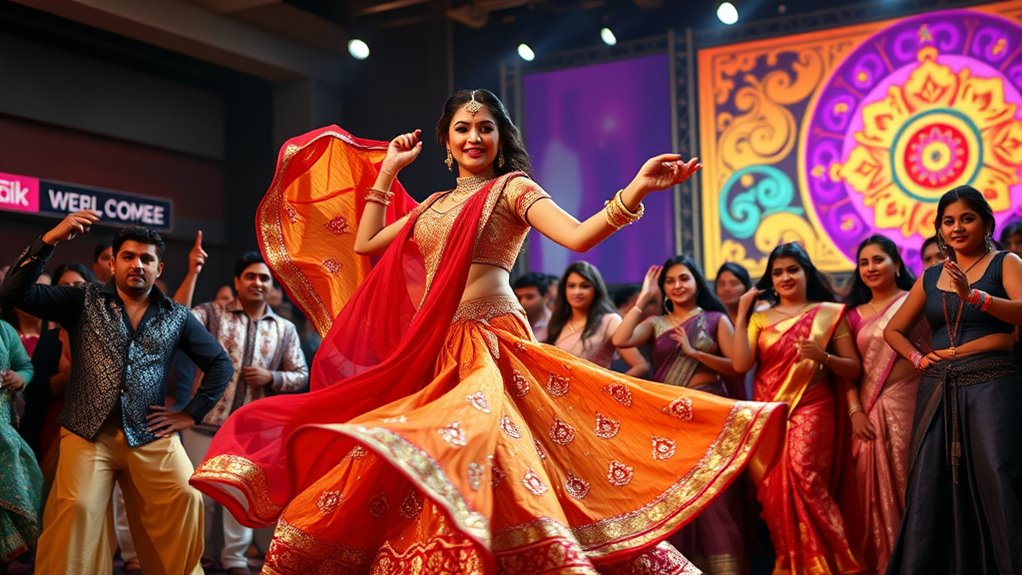
You can’t discuss the romantic dance vibe of the 2000s without mentioning “Dil Laga Na,” a track that captures passion and energy perfectly. Its lively beats and layered vocals create an irresistible atmosphere that makes it ideal for love-themed dance sequences. As a popular 2000s track, it left a lasting mark on Bollywood’s musical landscape. Incorporating music analysis techniques can further highlight the song’s impact and appeal.
Subheading 1: Romantic Dance Vibe
You should pay attention to:
- Its fusion of pop and electronic dance music, making it lively and modern.
- The romantic lyrics intertwined with high-energy beats that evoke passion.
- The dynamic dance sequences that showcase chemistry and excitement on screen.
- The choreography often incorporates multi-functional furniture and energetic movements that enhance the visual appeal.
- The use of innovative dance styles that have gained popularity for their choreographic complexity, which can be further appreciated through emotional support techniques to connect with the audience on a deeper level.
Subheading 2: Popular 2000s Track
Released in 2006, “Dil Laga Na” from Dhoom 2 quickly became one of the most energetic and memorable dance tracks of the 2000s, thanks to its infectious beats and catchy hooks. Its fusion of traditional and modern sounds, combined with high-energy choreography, made it a staple on dance floors and in competitions. You can see how the song’s fast-paced tempo and vibrant visuals elevated the film’s action themes and captivated audiences. Its influence extended beyond the movie, shaping Bollywood dance styles and inspiring remixes. The song’s lively vocals and dynamic instrumentation created a lasting impression. Below is a quick overview:
| Feature | Details |
|---|---|
| Choreography | Energetic, intricate footwork |
| Style | Contemporary with hip-hop elements |
| Cultural Impact | Popularized fusion dance in Bollywood |
6. Koi Kahe
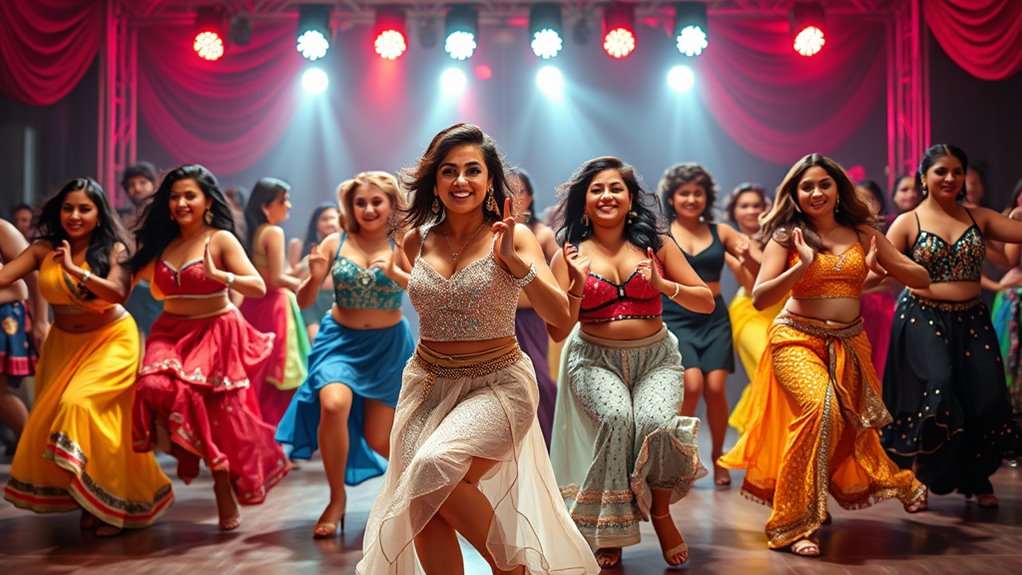
Have you ever wondered what makes “Koi Kahe Kehta Rahe” an enduring dance anthem from the early 2000s? Its infectious energy and fusion sound set it apart. Here are three reasons why it remains iconic:
- The upbeat composition by Shankar–Ehsaan–Loy combines Indian classical with Western pop, creating a fresh, vibrant vibe.
- The choreographed group dance emphasizes synchronized moves blending Bollywood flair with Western dance styles, perfect for energetic club scenes.
- Its portrayal of youthful camaraderie and urban culture made it a symbol of modern friendship and celebration.
This song’s lively vocals, catchy rhythm, and dynamic choreography continue to inspire dance covers and playlists, cementing its place in Bollywood dance history.
7. It’s the Time to Disco
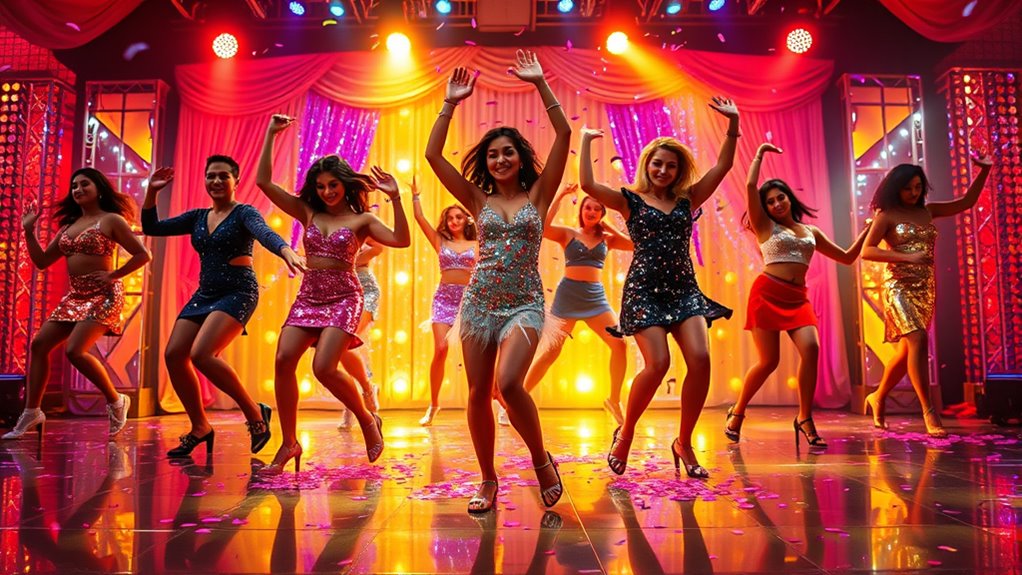
“It’s the Time to Disco” stands out as a vibrant highlight in Bollywood’s musical landscape of the early 2000s, capturing the energy of urban nightlife. From *Kal Ho Naa Ho* (2003), this song, sung by Vasundhara Das, KK, Shaan, and Loy Mendonsa, blends Indian classical sounds with Western disco beats. Composed by Shankar-Ehsaan-Loy and penned by Javed Akhtar, it features lively instrumentation with strings, brass, and tabla, creating an upbeat, party-ready vibe. The visuals showcase Shah Rukh Khan, Preity Zinta, and Saif Ali Khan dancing in a colorful club setting, emphasizing modernity and cross-cultural fusion. Its catchy chorus, celebrating carefree joy, made it a dance floor favorite. Recognized as an iconic Bollywood disco track, it influenced future songs blending Indian and Western styles.
8. Tere Liye

“Tere Liye” stands out as a romantic melody that gets everyone on the dance floor. Its lively beats and heartfelt lyrics make it perfect for energetic performances and celebrations. This song captures the essence of 2000s Bollywood’s love for catchy, danceable tunes.
Romantic Melodies
As one of Bollywood’s most cherished romantic melodies, “Tere Liye” from Veer-Zaara captures the essence of eternal love through its soulful lyrics and melodious composition. You feel the depth of devotion in lyrics like “Tere Liye Hum Hain Jiye,” conveying selfless love and resilience. The song’s gentle melody blends classical Indian elements with soft orchestration, creating a heartfelt mood. Its emotional peaks highlight themes of longing, separation, and unwavering commitment. The original vocals by Lata Mangeshkar add nostalgic warmth, making it timeless.
- Focuses on selfless love and emotional resilience.
- Combines classical Indian music with soft orchestration.
- Became an iconic symbol of romantic Bollywood ballads in the 2000s.
Dance Floor Hit
Released in 2010 as part of the film Prince, “Tere Liye” quickly became a staple on Bollywood dance floors, thanks to its energetic beat and catchy melody. Sung by Atif Aslam and Shreya Ghoshal, with music by Sachin Gupta, this dance-pop track features an upbeat tempo perfect for clubs and parties. Its memorable hook and lively choreography, set against a glossy nightclub backdrop, make it impossible not to move. The lyrics celebrate love and devotion, encouraging celebration and dancing with lines like “Tere Liye Jhoomu Deewana Ban Ke Tere Liye.” The song’s popularity skyrocketed, becoming a fixture in Bollywood dance playlists, remixes, and college events. Its energetic vibe and cultural impact solidify its status as one of the defining dance floor hits of the 2010s.
9. Chaiyya Chaiyya

“Chaiyya Chaiyya” stands out as one of Bollywood’s most iconic dance numbers of the 2000s, mesmerizing audiences worldwide with its infectious energy and soulful roots. Based on a 17th-century Punjabi Sufi folk song by Bulleh Shah, the song’s lyrics express love and spiritual devotion. Composed by A.R. Rahman, it blends traditional folk with modern beats, performed energetically by Sukhwinder Singh and Sapna Awasthi. The music video, directed by Mani Ratnam, features Shahrukh Khan and Malaika Arora dancing atop a moving train, showcasing daring choreography by Farah Khan. This visual spectacle, combined with its cultural depth, led to its global acclaim, including a BBC ranking. Its fusion of tradition and modernity makes “Chaiyya Chaiyya” a timeless Bollywood classic.
- Based on a Punjabi Sufi folk song by Bulleh Shah
- Features a daring train-top dance shot
- Combines folk roots with contemporary beats
10. Mauja Hi Mauja
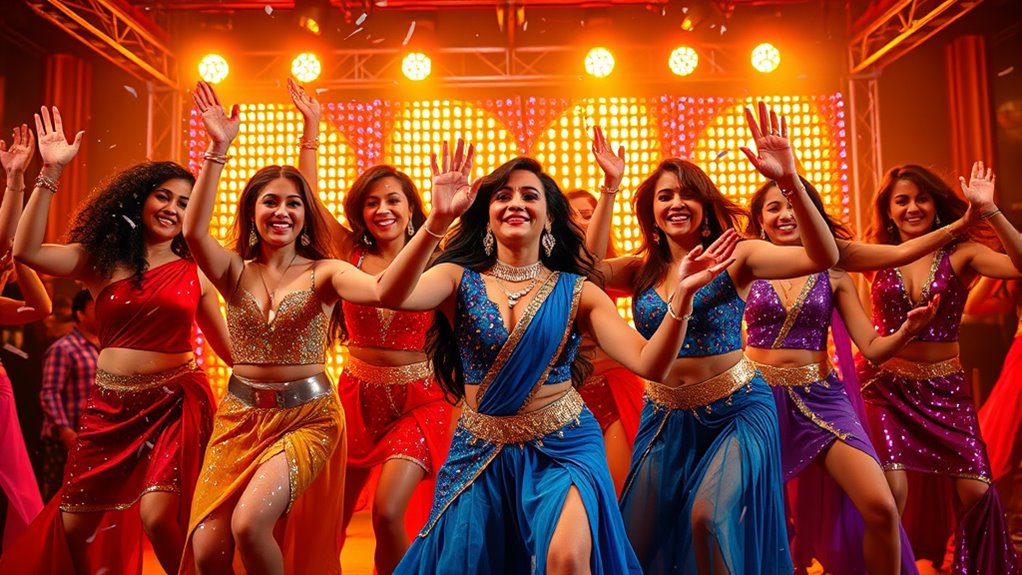
Building on the vibrant energy of Bollywood dance numbers, “Mauja Hi Mauja” stands out as one of the most memorable tracks from the 2000s. Featured in *Jab We Met*, this lively song, composed by Pritam and sung by Mika Singh, captures a carefree, celebratory mood. Its lyrics, blending Hindi and Punjabi, use metaphors and playful expressions that emphasize fun and enjoyment, with the chorus repeating “Mauja Hi Mauja” to highlight the song’s festive spirit. The music fuses traditional Punjabi folk instruments like dhols with modern Bollywood beats, creating an infectious rhythm that compels you to dance. Despite initial language barriers, its energetic melody made it a party favorite and an iconic dance number, forever linked to joyful celebrations across India.
Frequently Asked Questions
Which 2000S Bollywood Dance Songs Are Best for Parties?
You want the best Bollywood dance songs for parties, right? Focus on energetic tracks like “Dhoom Machale” and “Kajra Re” to get everyone moving. Upbeat numbers like “Dance Pe Chance” and “Jhoom Barabar Jhoom” are perfect for group fun. Don’t forget nostalgic hits like “You Are My Soniya” to evoke memories. These songs will turn your gathering into an unforgettable dance celebration!
How Did Bollywood Dance Trends Evolve During the 2000S?
Imagine Bollywood dance as a river flowing through time, constantly shaping new currents. In the 2000s, this river widened, blending classical roots with Western influences like hip-hop and contemporary styles. You see vibrant signature steps, energetic group routines, and the rise of viral moves fueled by reality TV and social media. This evolution made dance more accessible, diverse, and synced with global trends, transforming Bollywood into a dynamic dance landscape.
What Are the Most Iconic Dance Moves From These Songs?
You’ll immediately recognize the iconic dance moves from these songs. In “Dhoom Machale,” you see motorcycle-revving hand motions and group leans. “Kajra Re” features circular hand flicks and synchronized mirror steps. For “Sharara,” quick footwork and beach circle formations stand out. “Salaam Namaste” includes catchy hook steps and upbeat shuffles, while “Aaja Nachle” showcases folk-inspired twirls and hand claps. These signature moves defined 2000s Bollywood dance energy.
Which Songs Influenced Bollywood Dance Culture the Most?
Think of Bollywood dance culture as a river, constantly flowing and shaped by its tributaries. The songs that influenced it most are like major currents—”Dhoom Machale” with its high energy, “Kajra Re” for its catchy rhythm, and “You Are My Soniya” for viral appeal. These tracks transformed dance, blending traditional moves with modern flair, setting trends that continue to ripple through Bollywood today.
Are There Modern Remixes of These 2000S Hits?
Yes, you’ll find many modern remixes of these 2000s hits. Artists and producers often update classics like “Dhoom Machale” and “Kajra Re” with contemporary styles like EDM and trap, making them appealing to today’s audiences. These remixes are popular in social media dance challenges and new films, helping the songs stay relevant and introducing younger generations to Bollywood’s vibrant dance culture.
Conclusion
You’ve traveled through the vibrant world of 2000s Bollywood dance numbers. You’ve seen the energy in “Dhoom Machale,” the elegance in “Kajra Re,” the rhythm in “Sharara,” and the charm of “Chaiyya Chaiyya.” You’ve felt the excitement in “It’s the Time to Disco,” the passion in “Tere Liye,” and the joy in “Mauja Hi Mauja.” These songs capture the spirit, style, and unforgettable moments that defined an iconic era of dance.
